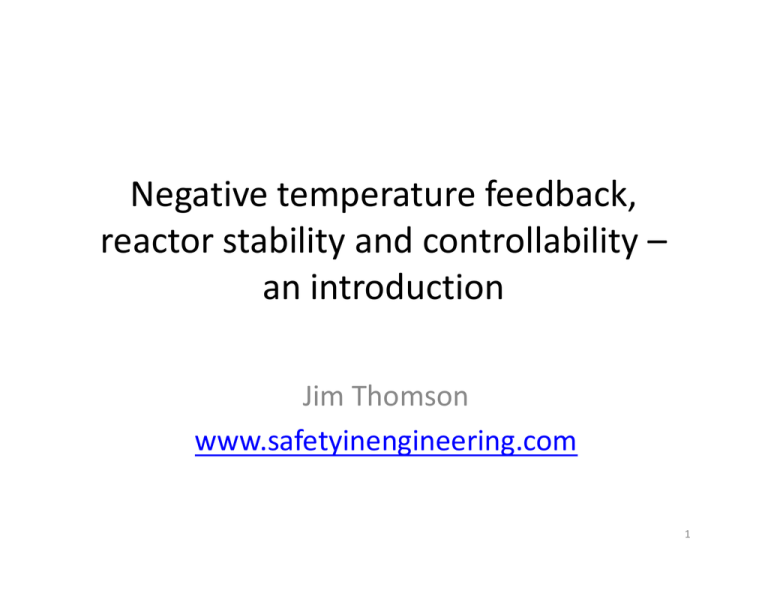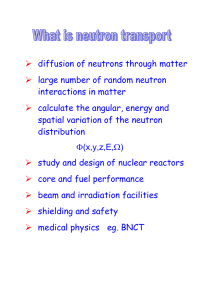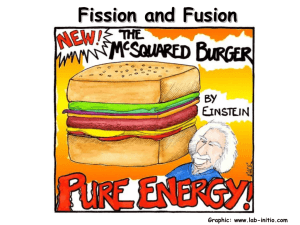Negative temperature feedback, reactor stability and controllability – an introduction Jim Thomson
advertisement

Negative temperature feedback, reactor stability and controllability – an introduction Jim Thomson www.safetyinengineering.com 1 www.safetyinengineering.com lost lost Effective multiplication factor keff = (no. of fissions in one generation)/(no. of fissions in succeeding generation) Reactivity ρ = (keff - 1.0)/keff which is ~ (keff - 1.0) for practical purposes. Prompt neutron lifetime (the time between a neutron being expelled from a nucleus, and hitting another one) is typically about one-thousandth of a second. The ‘lost’ neutrons are absorbed by non-fissionable materials. These include: • Shielding, • Structural steel, • Moderator, • Uranium-238 2 www.safetyinengineering.com Delayed neutrons Some neutrons (typically 0.65%) emitted in the fission process are delayed by up to several tens of seconds. The remaining 99.35% are released immediately upon fission (‘prompt neutrons’). This phenomenon gives a margin for control of nuclear reactors. Reactors operate in a so-called ‘delayed critical’’ state, compared to bombs which are ‘prompt critical’. 3 www.safetyinengineering.com 10 1 Fission yield % 0.1 0.01 0.001 70 90 110 130 150 Mass number The fission product spectrum for uranium-235 The fission product spectrum for uranium 235 Fission is a random process………… all sorts of elements get produced as fission products……………. 4 www.safetyinengineering.com 0.4 0.3 S(E) = 0.771(Ee-0.776E) 0.5 S(E) 0.2 0.1 1 2 3 4 5 6 Neutron energy, E, MeV The fission neutron energy spectrum ……and the neutrons get released at a wide range of speeds (or energies)……... 5 www.safetyinengineering.com MaxwellBoltzmann Spectrum Hardened spectrum n(v) Neutron speed (m/s) The Maxwell-Boltzmann distribution for thermal neutrons …….and even after the neutrons have been slowed down (moderated) they still have a wide range of speeds……………. 6 www.safetyinengineering.com 1 barn = 10-28 m2 fission crosssection (barns) Neutron energy Neutron energy Fission cross-sections for uranium-235 and uranium-238 …….and the chance that a neutron will hit another uranium-235 nucleus (and hence cause another fission) varies with the speed of the neutron………... 7 www.safetyinengineering.com total crosssection (barns) 1 barn = 10-28 m2 Neutron energy The total cross-section of uranium-238 ……also the chance that the neutron will be captured by uranium 238 (and not cause fission) also varies with the neutron speed. The peaks (‘resonances’) are important, and are caused by quantum mechanics effects....... 8 www.safetyinengineering.com U238 capture cross-section Doppler broadening of cross-section resonances neutron energy Doppler Broadening – as U-238 gets hotter, the resonance peaks broaden due to vibration of the nuclei. The nett effect is that U-238 absorbs more neutrons (without causing fission) as the reactor temperature increases. Hence an increase in reactor temperature leads to a fall in reactivity. 9 k-effective 1.006 Protection System trip settings (notional) 1.0000 (normal operation) prompt critical Prompt criticality increasing rate of power increase delayed critical Negative thermal feedback (passive) or control system action (active) or protection system action (emergency) sub-critical www.safetyinengineering.com 10 The ways in which temperature effects reactivity – passive control mechanisms www.safetyinengineering.com An increase in the temperature of the reactor leads to FUEL thermal feedback Doppler broadening More neutron capture by U238 (non-fissile, 97% of fuel) very fast, negative (fewer neutrons available for fission) An increase in mean neutron thermal energy Reduced neutron capture by U235 slow, negative (less neutrons cause fission) Increased neutron capture by Pu239 (due to 0.3eV resonance) slow, positive (more neutrons cause fission) Fewer neutrons absorbed in coolant fast, positive (more neutrons available for fission) Longer neutron mean free path fast/slow, negative (more neutrons escape from reactor) More neutrons captured in control rods slow negative (more neutrons captured in CRA’s) What happens to the neutrons? Effects on reactivity MODERATOR Increased steam voidage in watercooled reactors Expansion of the reactor structure STRUCTURE Expansion of control rods into the core Physical effect on reactor 11 www.safetyinengineering.com Passive thermal feedback Reactivity ρ + Neutron Kinetics - φ Thermal rating R (watts/g) Reactor power δρ= α.δ T Thermal feedback effects δT Fuel, coolant, moderator and structural temperature changes ∫ R dt α = the temperature coefficient of reactivity ρ = keff - 1 12 www.safetyinengineering.com SUMMARY Delayed neutrons make a nuclear reactor controllable. Doppler broadening makes a nuclear reactor stable. 13





